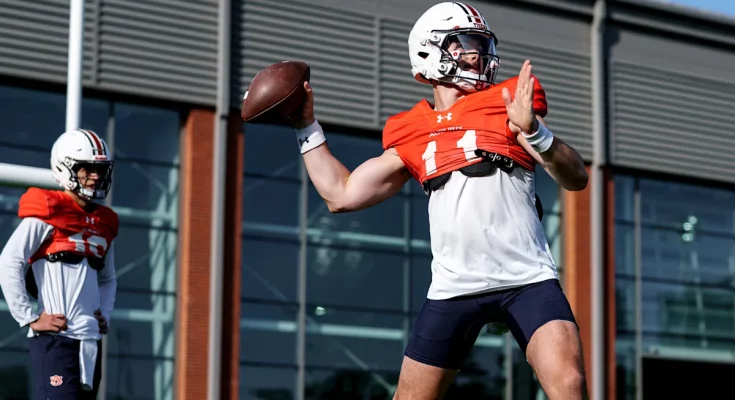**Hugh Freeze Admits Need to ‘Calm Down’ After Hat-Slamming Incident with Jackson Arnold**
The world of college football is no stranger to high emotions, intense rivalries, and sideline outbursts. Coaches, players, and fans alike ride the wave of adrenaline that comes with every snap, every drive, and every pivotal moment in a game. But sometimes, that passion spills over in ways that spark controversy. Such was the case when Liberty Flames head coach Hugh Freeze found himself in the spotlight after a heated sideline exchange with Oklahoma quarterback Jackson Arnold, culminating in Freeze slamming his hat to the ground in frustration.
The incident, which occurred during a tightly contested game, quickly went viral, drawing reactions from analysts, fans, and even Freeze himself. Known for his fiery demeanor and competitive spirit, Freeze later admitted that he needed to “calm down” in such situations, acknowledging that his emotions sometimes get the best of him. This moment serves as a microcosm of the larger conversation about coaching intensity, player-coach relationships, and the fine line between motivation and frustration in high-stakes sports.
### **The Incident That Sparked the Reaction**
During a critical drive in the game, Arnold, a highly touted freshman quarterback for the Sooners, made a decision that Freeze clearly disagreed with. Whether it was a missed read, a risky throw, or a failure to audible, the Liberty coach’s frustration was palpable. Cameras caught Freeze yelling in Arnold’s direction before dramatically slamming his hat to the ground—a moment that immediately became a talking point across social media and sports networks.
For those familiar with Freeze’s coaching style, the outburst wasn’t entirely surprising. He has built a reputation as an emotional leader, one who wears his heart on his sleeve. While that passion has fueled his success—leading programs like Ole Miss and Liberty to notable victories—it has also occasionally led to moments where his temper flares in public view.
### **Freeze’s Reflection: “I Need to Calm Down”**
In the post-game press conference and subsequent interviews, Freeze addressed the incident with a mix of accountability and self-awareness. “I’ve got to do a better job of keeping my emotions in check,” he admitted. “There’s a fine line between being passionate and letting frustration take over. I need to calm down in those moments because, at the end of the day, these are young men who are still learning.”
His comments struck a chord, particularly in an era where coaching behavior is under increased scrutiny. The days of unchecked sideline tirades—once a staple of football culture—are fading as the sport evolves. Players, parents, and administrators are more attuned to the psychological impact of coaching methods, emphasizing constructive criticism over public humiliation.
Freeze’s willingness to acknowledge his misstep was a step in the right direction. “I love our players, and I want them to succeed,” he said. “But I also have to remember that how I communicate in those high-pressure moments matters just as much as the message itself.”
### **The Broader Conversation About Coaching Intensity**
The incident between Freeze and Arnold is far from isolated. Across college and professional football, coaches have long been defined by their sideline personas. From Nick Saban’s infamous “ass-chewings” to Jim Harbaugh’s animated reactions, intense coaching styles are often celebrated as a sign of dedication. But where is the line between motivation and intimidation?
Sports psychologists argue that while high-energy coaching can elevate performance, it must be balanced with emotional intelligence. Dr. Jessica Bartley, a mental performance consultant, explains, “Athletes respond differently to criticism. Some thrive under fiery coaching, while others shut down. The best coaches know how to read their players and adjust their approach accordingly.”
In Arnold’s case, the young quarterback handled the moment with poise, later downplaying the incident in interviews. “Coach Freeze is a competitor, just like all of us,” Arnold said. “I know he wants what’s best for his team. It’s part of the game.” His maturity in responding suggests that the exchange didn’t leave lasting damage, but not all players—especially younger or more sensitive ones—may rebound as easily.
### **Freeze’s Redemption Arc and Coaching Philosophy**
Hugh Freeze’s career has been a rollercoaster of highs and lows. From leading Ole Miss to Sugar Bowl appearances to the off-field controversies that led to his resignation, his journey has been anything but smooth. At Liberty, he has worked to rebuild his reputation, both as a coach and as a leader. Moments like the hat-slamming incident serve as reminders of the growth he still seeks.
Yet, those close to Freeze emphasize that his passion is also his greatest strength. “He cares deeply,” said one Liberty assistant. “Sometimes that comes out in ways that look aggressive, but it’s because he wants his players to be great.” The challenge for Freeze—and coaches like him—is channeling that intensity in a way that uplifts rather than alienates.
### **The Player’s Perspective: How Athletes Handle Sideline Emotions**
For players, navigating a coach’s outbursts is part of the game. Some, like Arnold, take it in stride, using it as fuel. Others may struggle with confidence when faced with public criticism. Former NFL quarterback and current ESPN analyst Dan Orlovsky weighed in, saying, “Coaches have to remember that cameras are always watching, and these moments live forever. There’s a way to be demanding without being demeaning.”
The best player-coach relationships are built on mutual respect. When players know their coach’s outbursts come from a place of high standards—not personal attacks—they’re more likely to respond positively. Freeze’s admission that he needs to temper his reactions could actually strengthen his connection with his team, showing that even leaders must adapt.
### **The Role of Accountability in Leadership**
One of the most telling aspects of this story is Freeze’s willingness to own his mistake. In a profession where ego often overshadows humility, his public acknowledgment stands out. “Leadership isn’t about being perfect,” he said. “It’s about recognizing when you’re wrong and making it right.”
This level of accountability resonates with players. When a coach models self-awareness, it sets a standard for the entire program. It also humanizes him, making him more relatable to his team.
### **Conclusion: Passion vs. Composure in Coaching**
Hugh Freeze’s hat-slamming moment was a brief, viral spectacle, but the lessons it carries are lasting. Coaching at any level requires a delicate balance between passion and composure. The best leaders know when to push and when to pause, when to raise their voice and when to offer a steady hand.
Freeze’s admission—that he needs to “calm down”—isn’t a sign of weakness but of growth. In a sport where every second counts, the ability to reflect and adjust may be the most valuable skill of all. As the season progresses, all eyes will be on how he channels his intensity, not just in games, but in the way he leads his team.
For now, the incident serves as a reminder: in football, as in life, emotions will rise. But true leadership is about how you handle the aftermath.



